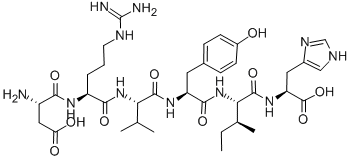angiotensin i/ii (1-6) is a peptide (asp-arg-val-tyr-ile-his) that contains the amino acids 1-6 and is converted from angiotensin i/ii peptide.angiotensin i is formed by the action of renin on angiotensinogen, an α-2-globulin with 12 amino acids. angiotensinogen is produced constitutively and released into the circulation mainly by the liver. renin cleaves the peptide bond between the leucine (leu) and valine (val) residues on angiotensinogen, creating the ten-amino acid peptide angiotensin i. angiotensin i is converted to angiotensin ii (aii) through removal of two c-terminal residues by angiotensin-converting enzyme (ace), primarily by ace within the lung.angiotensin is a peptide hormone that causes vasoconstriction and a subsequent increase in blood pressure. angiotensin also stimulates the release of aldosterone, which promotes sodium retention in the distal nephron, thereby increasing blood pressure.figure1 formula of angiotensin i/ii (1-6)
1. Basso N, Terragno NA (December 2001). "History about the discovery of the renin-angiotensin system". Hypertension 38 (6): 1246–9. 2. Richard A. Preston. et. (1998). “Age-Race Subgroup Compared With Renin Profile as Predictors of Blood Pressure Response to Antihypertensive Therapy”. JAMA. 1998;280(13):1168-1172.3. Williams GH, Dluhy RG (2008). "Chapter 336: Disorders of the Adrenal Cortex". In Loscalzo J, Fauci AS, Braunwald E, Kasper DL, Hauser SL, Longo DL. Harrison's principles of internal medicine. McGraw-Hill Medical.

